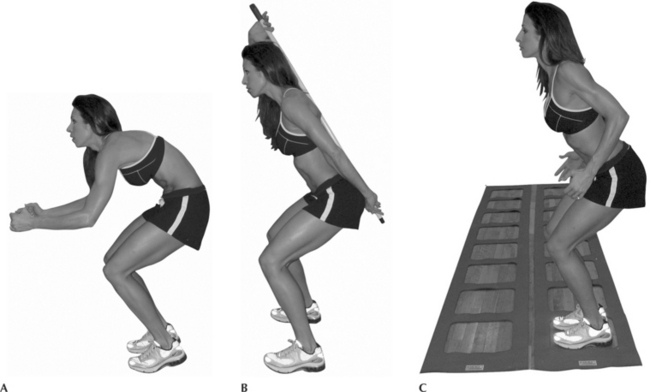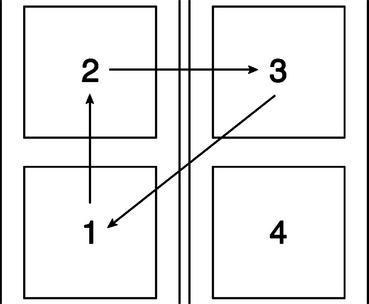Chapter 14 Plyometrics in Rehabilitation
FUNCTIONAL PROGRESSION
In Review
Functional progression is a series of basic movement patterns graduated according to the difficulty of the skill and an athlete’s tolerance.1 The primary objective of functional progression in rehabilitation is an athlete’s timely and safe return to competition. From a prevention standpoint, it is the optimal preparation for the specific demands of a sport. At the heart of functional progression is the SAID principle (specific adaptations to imposed demands), which simply means that physical activities should be appropriate and strategic in preparing an athlete for the demands of his or her sport including such components as acceleration/deceleration of movement, specific velocities of movement, planes and ranges of motion, varied degrees of dynamic trunk stabilization, and coordinated whole body patterns of movement.
Tippett and Voight1 provided guidelines governing the advancement of a functional progression program:
The exercises should progress in the order listed:
In Figure 14-1, B a dowel is used as a cue for proper alignment from the head/neck, trunk, and low back/pelvis. In a squatting posture the spinal curves should change and adjust to the anterior tilt of the pelvis. As the pelvis tilts forward, the lumbar vertebrae are forced anteriorly, thereby increasing lumbar concavity (lordotic curve). The line of gravity (LOG) therefore is at a greater distance from the joint axes of the spinal segments, and the extension moment is increased at both the cervical and lumbar regions. The posterior convexity of the thoracic curve increases slightly and becomes kyphotic in order to balance the greater-than-normal lordotic lumbar curve. Referring to the dowel, the contact points of the body along the dowel are at the head, a midpoint along the thoracic spine, and base of the lumbar spine-pelvis, which assists the athlete in maintaining the three adjusted spinal positions—increased cervical, thoracic, and lumbar curves that accompany an increased anterior pelvic tilt. Figure 14-1, C also demonstrates the correct posture for the “freeze” positions, which are discussed later in the section on landing strategies. Therefore as an athlete jumps forward/back and “freezes,” he or she needs to land while maintaining this posture. By maintaining the anterior pelvic tilt and proper curves of the spine and not flexing at the head/neck and trunk or losing lumbar lordosis, the athlete will be in the most effective position for subsequent takeoff. This is an example of dynamic postural control training, which is part of the plyo-support phase following the development of an adequate strength base.
PLYOMETRIC IN NATURE
The practical definition of plyometrics is a quick, powerful movement involving prestretching or countermovement that activates the stretch shortening cycle (SSC) of muscle.2 Within this powerful movement is an eccentric phase or force reduction phase; amortization phase or transition moment involving dynamic stabilization; and concentric phase or force production phase.3 Although it is common to view plyometrics as a by-product of muscle activity alone, the nervous system must be considered as well. Ultimately, the purpose of plyometric conditioning is to heighten the excitability of the nervous system for improved reactive ability of the neuromuscular system as a whole.2 If one considers the parameters that go into describing a plyometric exercise including the use of the stretch reflex and taking advantage of the elastic rebound tendency of muscle tissue, then the definition can be broadened to include many exercises that are “plyometric in nature.”4
INTENSITY AND WORK VOLUME
Strategic and Appropriate: More Is Not Better!
Table 14-1 adjusts work volume (total foot contacts) and intensity on the basis of seasonal periods and an individual’s “readiness for plyometrics.” The recommended volume of specific jumps in any one session will vary with intensity and each workout’s objectives. Table 14-1 shows how work volume should vary for beginning, intermediate, and advanced workouts.4 For example, a beginner in one workout during the off season could complete 60 to 100 foot contacts of low-intensity exercises, while the advanced exerciser might be able to do 120 to 200 foot contacts in one off-season workout. With low-intensity jump training, the work volume accumulates quickly. Note that an athlete performing two sets of each of the following exercises will complete 280 foot contacts in one workout using the four-square formation (Figure 14-2).
Consider: 1 set of each exercise above = 140 foot contacts, 2 sets = 280 foot contacts.
FREQUENCY AND RECOVERY
Adequate recovery between each set in a workout is equally as important as adequate rest between workouts. A common work-to-rest ratio is 1:5 (e.g., an exercise that takes 10 seconds to perform would have 50 seconds rest between sets). An important point to consider with low-intensity plyometric exercises, particularly the footwork patterns presented in this chapter, is that they are “submaximal” in nature. With this in mind, fatigue should not be a factor with this type of work. As stated earlier and also later in this chapter, proprioception, postural control, and dynamic stabilization are points of emphasis with this mode of exercise. Again, fatigue should not be an issue if an athlete follows a course of progression including development of an adequate strength base (i.e., squats and step-ups) and practices landing strategies with adequate body control before performing actual working sets of low-intensity jump training. An athlete will not reach a fatigue state given the submaximal intensity, short duration of activities, and appropriate work-to-rest ratios. As mentioned earlier, submaximal footwork patterns/jumps are often used as part of a warm-up in preparation for moderate- and high-intensity plyometrics.4 Otherwise, they can be placed toward the end of a workout, following the primary work of the day (weight training, sprinting, and agility drills).
SAFETY CONSIDERATIONS
Allowing time for an adequate warm-up is another important safety consideration in preparing for low-intensity jump training. “Jump rope” is one simple way to prepare for the low-intensity jump patterns, for example:
READINESS FOR PLYOMETRICS
Medical and Orthopedic Considerations
At this point, emphasizing a crucial piece of the puzzle in successful plyometric training is necessary. Eccentric strength, or the ability to control the lengthening of a muscle under tension, is vital to becoming faster and jumping higher.5 When the force exerted on a muscle exceeds the force developed by the muscle, work is done on the stretching muscle and in the process the muscle absorbs mechanical energy. If this energy is dissipated as heat, the muscle is acting as a shock absorber. If the temporarily stored energy is recovered as elastic recoil energy, it results in a muscle that then shortens in a concentric muscle contraction. This is known as the stretch-shortening cycle (SSC), and it results in improved economy of movement through a significant enhancement of the power output of subsequent contractions. In this way the muscles of the lower extremities are behaving as springs that cyclically absorb and recover elastic recoil energy. The other fundamental facts surrounding eccentric contractions are that the energy costs are unusually low and the magnitude of the force produced is unusually high. Therefore resistance training to improve eccentric strength is important to prepare the muscles and tendons for the stress and strains encountered in plyometric training.6 The better prepared the muscles are in this area, the bigger the shock absorbers. Eccentric exercise performed as a regular part of the preparation of the athlete or as part of his or her rehabilitation program requires minimal energy/oxygen support and will increase strength and power in all individuals. The conclusion to be reached is that eccentric strength training should be part of all rehabilitation programs, as well as all performance-enhancement programs.
Body weight and strength ratios are also important factors to consider when initiating plyometric training. For instance, it is suggested for an athlete to be able to perform a back squat with 1.5 times his or her bodyweight (1RM) before beginning high-intensity plyometrics, such as depth jumps.4 This can be a dilemma for a high school athlete who could otherwise benefit from a plyometric program but lacks this type of strength due to a lack of maturity or training background. When an athlete is running, he or she is already imposing up to three times his or her body weight in forces through the knees. Without the time, maturity, and preparation to obtain these types of strength levels, what alternatives might exist? As stated earlier, low-intensity plyometrics, such as submaximal footwork patterns, are a healthy alternative for young athletes who lack an adequate strength base to perform high-intensity plyometrics.4 Continuing with the adolescent or prepubescent athlete as an example, the submaximal footwork patterns will teach a young athlete to control his or her center of gravity, land softly, change direction quickly, and spend as little time on the ground as possible. Low-intensity plyometrics can then be viewed as support work for healthier training in young athletes when combined with body weight resistance strength work and landing strategies, as well as development of eccentric strength.
The concept of developing the base of strength within an athlete must never be lost during the training process. The types of strength necessary to improve or maintain performance can only be developed through adequate, monitored, and challenging resistance training programs. The fact that free weight lifting provides the exerciser with the resistance necessary to create greater force production, potential for power development, and faster speed of movement is a well-established concept. These movements are integral to the “functional training” or “sport-specific” philosophies followed by therapists and strength and conditioning coaches today. The following strength training exercises are examples of the progressive sequence that should be typically followed as one prepares to undergo the rigors of plyometric training.
Stay updated, free articles. Join our Telegram channel

Full access? Get Clinical Tree











